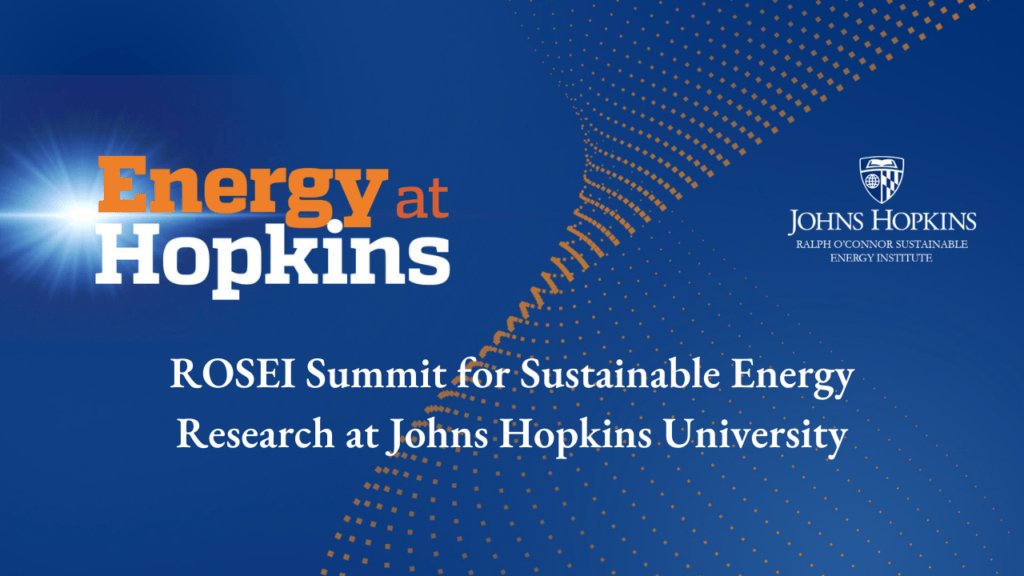January 18, 2023
8:00 am
The Ralph O’Connor Sustainable Energy Institute (ROSEI) is hosting an all-day in-person summit on January 18 to display different research being conducted at Johns Hopkins University (JHU) in the sustainable energy and materials fields. ROSEI’s goal for the event is for the Hopkins community to learn about and share the entirety of the sustainable energy and related research being conducted at the school.
Any JHU-affiliated can present their current or latest research in these areas at this university-wide event. This includes:
- Graduate students
- Postdoctoral candidates
- Research scientists
- Engineers
- Faculty
The period to register to present closed on December 14. Please click here to see the agenda of speakers for the Summit.
Information for those presenting:
- ROSEI’s summit is a combination of a broad number of topics and expertise. We have intentionally placed some broad variety of approaches even within sessions. We encourage you to go to sessions far from your usual haunts and learn as broadly as you can about energy at Hopkins!
- The plan is to have four different groups going during a session in four different classrooms. Each block on the agenda will have the allotted time indicated directly above the block to go through presentations.
- Presenters will have 15 minutes to speak. You should aim for 12-13 minutes of presentation and a couple minutes for audience questions.
- Presenters will be using their own laptops for presentations.
- Along with the agenda, also attached is the ROSEI PowerPoint template that we encourage people use for their presentations.
- Nametags for speakers will be made in advance and available in the first-floor lobby of Hodson Hall throughout the day of the Summit.
There will be keynote main sessions at the summit with all who attend, as well as several breakaway opportunities for people working in similar areas to collaborate and share ideas in small groups. There will also be presentations from the leaders of ROSEI’s four research pillars – Carbon, Storage, Wind and Grid – who will discuss their current research and the impact it can have in the fight against climate change.
The periods to register to present and strictly attend have closed.
Please continue to check this page as more information about the event becomes public. And see below if you would like to learn more about ROSEI’s four pillars, and the main work being pursued in each area.
Carbon
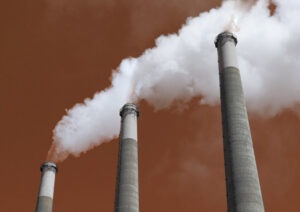
Carbon
Combatting carbon dioxide output is one of the main pillars ROSEI is founded upon. ROSEI’s main focus in this area is on a novel attempt at extricating the carbon in CO2 and converting it into a form of solid carbon useful in applications ranging from farming to construction. Led by ROSEI leadership council members Jonah Erlebacher and Chao Wang, these efforts are house under an initiative titled “Negative Carbon Carbon (NC2).”
“If we can do this, we would be the first in the world to demonstrate a complete carbon-to-carbon route, in which so-called ‘bad carbon’ is transformed into a globally useful ‘good carbon,’” Erlebacher says.
Storage
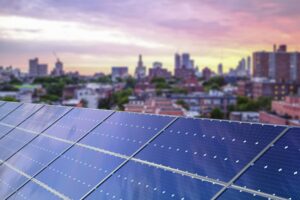
Storage
ROSEI’s main work in this area is funneled through the Light-Integrated Technology for Energy Storage (LITES) Initiative, which is attempting to use two different methods to expand solar energy’s uses. The first method involves the creation of new flexible, lightweight, high-efficiency solar technology with light-collecting capabilities, while the second focuses on photobatteries, which integrate two functions into one device without sacrificing either energy generation or storage performance. The research is led by a trio of ROSEI leadership council members: Jeff Maranchi, Sara Thoi and Susanna Thon.
“We aren’t trying to come up with just incrementally better ways to store solar energy; we’re attempting to establish a whole new paradigm for solar energy where the generation and storage are integrated into one system,” Thon says.
Wind
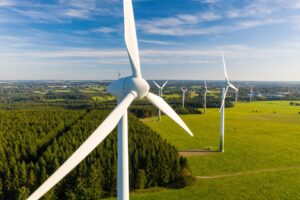
Wind
Wind power is rising. Having grown from supplying less than 2 to over 8% of US electricity in only a few years, this renewable source of energy is a disruptive technology that can help usher in a sustainable energy future. One impediment to increasing reliance on this clean, sustainable power source is the vast size of many windfarms and the challenge of understanding turbine-turbine and turbine-atmosphere interactions. These interactions affect wind farm performance on a variety of levels—from power output to turbine loading and maintenance.
High performance computer simulations can help by providing detailed insights into fluid mechanical effects associated with turbine placement, layouts, and environmental factors. Led by Dennice Gayme and Charles Meneveau, ROSEI has started an initiative focused on creating a public database of windfarm simulations, which will allow anyone with an internet connection to easily access and analyze the data in order to conduct research, generate knowledge, and evaluate models or wind field data to be used in wind farm planning or development projects.
Grid
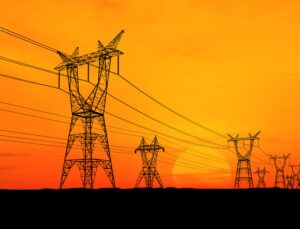
Grid
The purchase and delivery of power through a grid that relies almost entirely on renewable energy and new paradigms for energy storage is vastly different from today’s grid. Our team is developing a complete power systems laboratory utilizing a simulation and hardware-in-the-loop platform that will interface software solutions developed by the ROSEI team – such as models and algorithms for efficient power grid and market operations – with a robust simulator emulating an inverter-dominated power grid. The focus on high-impact and high-visibility applications distinguish this ROSEI Research Initiative from other testbeds. We are also working with partners to bring these solutions to today’s power systems as expediently and equitably as possible.
Faculty leaders in this area include Yury Dvorkin, Dennice Gayme, Ben Hobbs, and Enrique Mallada.
